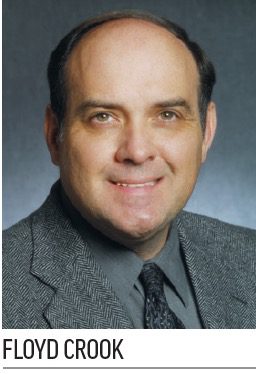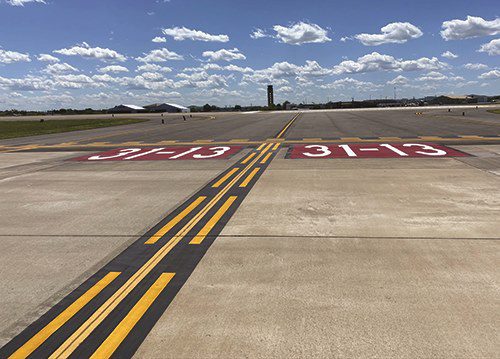People use the phrase “Don’t paint yourself into a corner” to offer advice about everything from business strategies to personal relationships. It also can apply, somewhat literally, to airports that establish years of fixed budgets for airfield marking projects. Sadly, many end up overspending. 
People use the phrase “Don’t paint yourself into a corner” to offer advice about everything from business strategies to personal relationships. It also can apply, somewhat literally, to airports that establish years of fixed budgets for airfield marking projects. Sadly, many end up overspending.
 Nashville International Airport (BNA) has taken a different approach to the ongoing task to avoid painting itself into a proverbial corner, and to avoid paying too much in the process. In early 2018, it started using a high-tech mapping system that helps the airport pinpoint specific spots and areas of markings that require maintenance as identified by BNA’s Operations Team during daily and monthly inspections. As a result, it is able to reduce the scope for many paint projects, which saves time and money.
Nashville International Airport (BNA) has taken a different approach to the ongoing task to avoid painting itself into a proverbial corner, and to avoid paying too much in the process. In early 2018, it started using a high-tech mapping system that helps the airport pinpoint specific spots and areas of markings that require maintenance as identified by BNA’s Operations Team during daily and monthly inspections. As a result, it is able to reduce the scope for many paint projects, which saves time and money.
“Before 2015, our markings program was somewhat fragmented,” explains Floyd Crook, BNA’s director of maintenance. “We decided we needed a complete assessment of our markings plan, so we hired a consultant, Sightline, to do a complete assessment of our airfield during the winter of 2014-2015.”
|
facts&figures Project: Airfield Markings Assessment Location: Nashville Int’l Airport Consultant: Sightline Markings Assessment: $30,000 Airport Staff Training: $15,000 Mapping System Implemented: Jan. 2018 Markings Assessments: Daily by airport staff; annually by Sightline Last Staff Training: July 2019 Airport Maintenance Employees: 75 Contractors: Markings Impressions Corp. dba Pope Striping; Pavement Restorations Inc. Key Benefits: Targeted assessment of markings is reducing maintenance costs & increasing quality |
Sightline recommended that instead of setting a fixed budget and replacing markings on a calendar basis, BNA should address markings gradually, as they begin to show the need. The outside contractor also counseled the airport to enroll some of its experienced maintenance workers and contractors in the company’s training program so they could perform regular inspections to help identify when markings needed cleaning or repainting.
Daniel B. Brown, the airport’s manager of safety and quality assurance, oversees the program. One of the first things he did was increase the oversight of outside contractors. “In the past, a company would apply markings, and there would be little to no oversight,” he explains. “We trained our inspectors as to what had to be done.”
The airport also began requiring contractors to provide their own quality control. “Before contractors leave for the day, we have to make sure they did what was required,” Brown says. “We want to see each contractor catch their own nonconforming items 90% of the time.”
In addition, Brown’s Inspection personnel check daily that the materials being applied are exactly what the specifications require and to which the contractor agreed. Brown insists on using high-quality materials that conform to or exceed FAA requirements. As such, crews primarily use Type III paints and beads as they seem to work best for the airport’s needs. “We want to make sure that the materials follow FAA guidelines and the manufacturer’s recommendations for application,” he relates.
As part of the process, Brown’s inspectors carefully monitor weather forecasts because high humidity, rainfall and extreme temperatures can all adversely affect paint’s quality. If conditions are not right for application, they will delay the work until the weather improves. “We are all flexible, including the contractors,” Brown adds. “We make sure our contractors are flexible and are on-call for the next morning or next night for emergency work.”

Every day, Brown’s inspectors assess the runways and taxiways, aided by a geographic information system (GIS) on their laptops and cellphones. When they find an area that needs maintenance, they take photos so crews can repair the pavement at exactly the right location. The mapping system can identify small spots that need treatment, as opposed to an entire runway.
So far, FAA inspectors have commented favorably on the improvement in the airport’s markings.
In-House & Outsourced Elements
Getting key maintenance staff trained to inspect runways and taxiways was an important precursor for BNA’s new approach. Mike Speidel, vice president with Sightline, emphasizes that it’s also vital to long-term quality.
“Our Airfield Marking Professional (AMP) certificate training is considered among the best in the industry,” says Speidel. “We think the cost [$15,000] will help all participants to go back to their airports and save a lot of money when it comes to maintaining markings.”
Speidel suggested the following three-step approach to BNA for maintaining its airfield markings. However, other airport operators can follow the same strategy:
- Understand FAA requirements
- Conduct objective assessment
- Clean more and paint less
Visual inspections performed daily by airport operations personnel work in concert with annual analysis by Sightline in spring. In fact, BNA recently issued the company a new four-year contract to provide continuous assessments of its airfield markings. The last assessment, completed earlier this year for $30,000, was performed with Sightline’s Mobile Retro-reflectometer (Mobi) scanning unit. “This device took hundreds of thousands of scans of the pavement markings,” Speidel explains. “We then transposed color-coded data on a good aerial shot of all the runways, and showed which sections needed repair and which were OK.”
The data provides airport management with a comprehensive blueprint to follow for future work, and maintenance employees trained and certified by Sightline perform daily assessments. Any problems on the main runways, especially in the landing and takeoff areas, receive top priority.
 Sightline’s recent assessment included a recommendation to remove painted markings that had built up over the years. “The runways were the biggest issue,” Speidel says. “The paint markings were very thick. When planes landed, tire contact would accelerate chipping.”
Sightline’s recent assessment included a recommendation to remove painted markings that had built up over the years. “The runways were the biggest issue,” Speidel says. “The paint markings were very thick. When planes landed, tire contact would accelerate chipping.”
In 2015, Sightline’s recommendations included significant quantities of marking removal. As a result, an outside contractor removed the buildup on Runway 2 Right, on the east side of the airfield. “This work is expensive, but necessary,” Speidel comments. “We suggested up front that the airport add this to their budget.”
The majority of the new markings, applied by Markings Impressions Corp., are expected to last at least five years. “Nashville now has one of the highest quality markings systems I have seen,” Speidel reports. “They paid attention to details.”
To achieve the best results, he advises airports and contractors to focus on:
- Project Design
- Materials Selection
- Surface Preparation
- Application
- Inspection

Financial Implications
Since adopting the new inspection and maintenance strategy, management at BNA is pleased with the quality and bottom-line costs of recent markings projects. “In the past, we budgeted to paint the surfaces on a four-year basis,” says Crook. “We would do one-quarter of the surfaces every year, so that after four years, all the surfaces would have been painted, whether they needed the work or not.”
The savings to the airport were significant. Caitlin Dillon, design project manager with Metropolitan Nashville Airport Authority, estimates that BNA saved about $350,000 from its markings budget this year alone.
Crook expects the savings to continue for several years. “Our intent is to get yearly assessments that will show us immediately what sections of the markings need the most work,” he explains. “This will help airport officials prioritize their projects.”
In short, BNA prefers its new full-spectrum approach because of the results it produces from targeted expenditures made only as needed.



